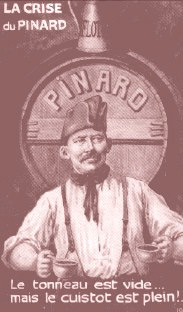Drinks
Water
At the start of the war, the only drink distributed to the soldier was water, sometimes mixed with coffee or tea. Water, usually referred to as flotte, became a major issue for the army following the 1914 epidemics which broke out as a result of the sources often being contaminated. With the stabilization of the front, the engineers set up a network of foraging and distribution of potable water which often didn't make it up to the first line. 'Bleached' water, which was purified chemically by a solution of hypocholride and sodium cholorate, was occasionally used. Needless to say, the taste was not very appealing and more than not, the men simply went without. Thus, accounts reporting on the poilus' thirst at the front are numerous.
Wine

Additionally, French soldiers often supplemented their ration by purchasing extra amounts of wine directly from the quartermaster that could be reimbursed at a later time. When at the front, bottles of wine could be bought in the rear by using the cyclist battalion as an intermediary, which was often done. When at the rear themselves, soldiers could get their wine from local business or civilians. Some accounts say that the average poilu drank several liters of pinard a day. Some soldiers mixed liquor with their wine to make it more potent. Later there were reports of them lacing it with ether as well, a mixture referred to as agnol. In the colder seasons, vin chaud (mulled wine or hot spiced wine) was very popular. Pinard was the source of numerous discussions and the inspiration for many songs, poems and writings.
Pinard's Influence on the Poilu's Morale: Depression. 1st cup: Pacifist. 2nd cup: Optimist. 3rd cup: Fired Up. 4th cup: Neutralist. 5th cup: Pessimist
Coffee and Liquor
Coffee was the other main drink of the army and was considered so vital that it was usually referred to as jus ("juice"). Often it was too clear or too sweet. Soldiers sometimes decided to form pairs, where one carried coffee in his canteen and the other carried wine. Alternately, a man might have two canteens, each holding a different liquid. This was particularly common when the soldier was marching to the front or going into the assault. Milk was not common and if the soldiers had any form of creamer at all, it came from cans of condensed milk.
Beer and cider (in 1/2 liter amounts) were also issued though much less often compared to wine. Eau-de-vie ("spirits") was rationed to the poilus but only in very small amounts or on selected occasions. Usually this was brandy, made from apples or grapes. One common brandy distributed to the ranks was called 'tafia (short for ratafia, which was fermented from grape skins or raisins. Rum was also issued to a lesser degree. A common habit was to mix the alcohol ration with coffee or wine in the canteen. However, the men could also either purchase additional alcohol or produced their own in small batches. It went by many nicknames including gnôle/gniôle or cric, which mean "hooch" or "booze".
It could also be purchased in the rear, as when the soldier went of furlough. Vermouths, liqueurs and brandies were the most popular among the men, and brand names like Pernod (Ricard) and Cointreau could be easily acquired. Cognac was more popular among the officers. Finally, though it had been banned in May 1915, absinthe could still be had and enjoyed the great popularity among the ranks as it had in the civilian world.



